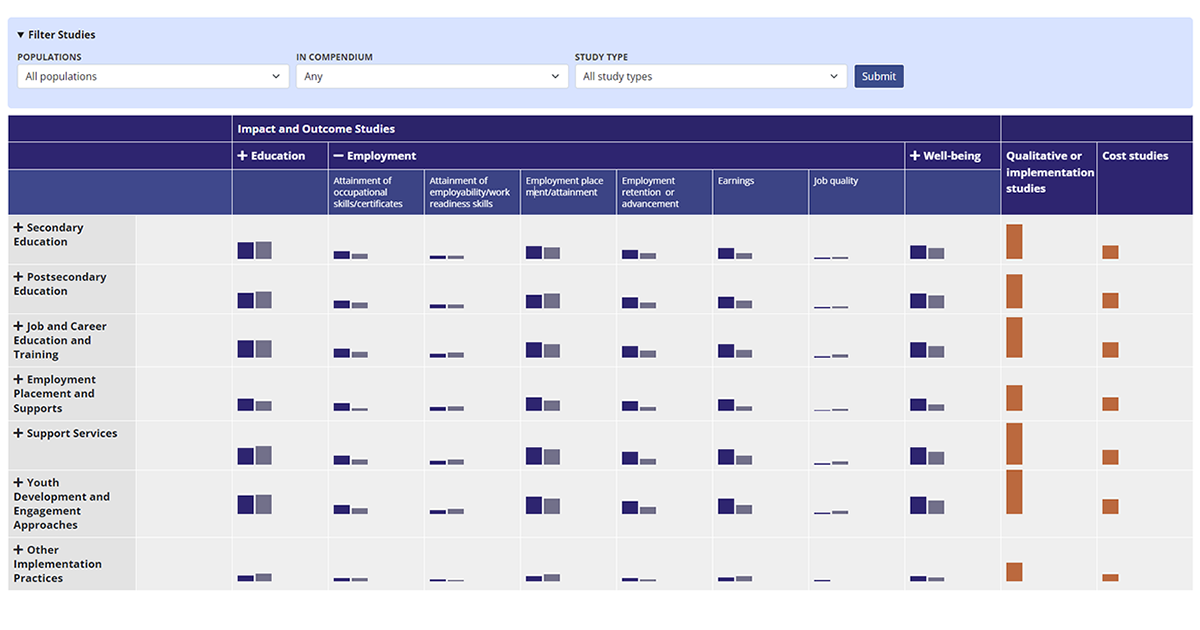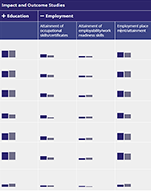Reconnecting Young People to School and Work
A Map of Evidence and Opportunities

 The Reconnecting Youth evidence gap map aims to systematically summarize the available evidence about the practices used by programs in the United States to support young people who experience disconnection from school and work during their transition to adulthood, often referred to as opportunity youth. The evidence gap map provides information about what evidence exists and insights into where there are opportunities to build evidence.
The Reconnecting Youth evidence gap map aims to systematically summarize the available evidence about the practices used by programs in the United States to support young people who experience disconnection from school and work during their transition to adulthood, often referred to as opportunity youth. The evidence gap map provides information about what evidence exists and insights into where there are opportunities to build evidence.
The evidence gap map focuses on programs targeting education and employment outcomes that serve young people who have had experiences that put them at greater risk of long periods of disconnection from school and work, such as not having a high school credential, being parents, or having been involved with the foster care or justice systems. The map contains 60 studies, and includes experimental designs, outcome studies, qualitative studies, and cost studies.
Key Findings
- There is a sizable volume of research about programs that serve opportunity youth, but most are not impact studies. The studies in the evidence gap map include a large number of qualitative studies. Many studies combined qualitative approaches with quantitative measurement of outcomes, either through measuring impact to a comparison group or measuring participant outcomes. The qualitative studies provide many opportunities to learn about how practices were implemented in diverse settings, which can provide lessons to strengthen programs. Less than half of the studies were impact studies that measured the causal effect of programs on outcomes.
- Studies in the map are of programs that primarily serve people under 25, but most do not focus on a specific subpopulation. Although the scope of the map was defined such that studies could serve both young people (ages 16 to 24) and people older than 25, few studies of programs that served both age groups met the criteria, indicating there is not much evidence about how well adult-focused programs serve Workforce Innovation and Opportunity Act Out-of-School–eligible youth (WIOA OSY). There are limited studies in the map that focus on the outcomes or experiences of specific subgroups of young people (for example, young parents or youth in the foster care system).
- The programs studied were comprehensive in the practices they employed, and the overwhelming majority utilized youth development approaches. Programs in the map focused on nearer term practices in a youth’s reconnection. Most programs provided services across domains, combining education and job training, and incorporating youth development practices to meet the interests and needs of a diverse group of participants. Practices associated with later steps on education and employment pathways (for example, postsecondary education advising and coaching after enrollment, or supports to maintain employment) were less common in the studies, as were practices that reflect a specific approach to program design or implementation (for example, two-generation or career pathway models).
- The studies measured a range of education and employment outcomes, with a stronger focus on short-term outcomes, and a lesser focus on wellbeing outcomes. Both outcome and impact studies were used to examine a range of education and employment outcomes. Intermediate and short-term outcomes, such as enrollment in education or job attainment, were more frequently measured than long-term outcomes, such as postsecondary degree attainment or job retention. Outcomes related to a young person’s wellbeing, such as housing or mental health, appeared less often and were mostly measured in large impact studies.
- Together, the Reconnecting Youth program compendium and evidence gap map point to areas where additional research is needed to bridge the gaps between practice and evidence, as some practices were common in the compendium but rare in the evidence gap map. A separate program compendium created for this project provides information about 78 programs and the practices they employ. Comparing the practices reported by those programs and the practices that were documented in the studies in the map highlights some practices where there is minimal research, although programs report the practices are widespread. These “gaps” can be used to set priority areas for future research.
The evidence gap map can be used to develop a research agenda in the following ways:
- Explore areas with a concentration of studies to deepen learning. The evidence gap map systematically catalogs and organizes studies of programs with a similar scope, allowing researchers to identify areas where systematic review or meta-analysis might be appropriate. The wealth of qualitative studies in the map could be further analyzed to explore the range of implementation approaches of a practice, and best practices for engaging and working with WIOA OSY–eligible young people. Additionally, a systematic review of the outcomes reported in the studies, whether measured against a comparison group or not, could provide more insights into the experiences of these young people and their range of outcomes.
- Explore the gaps in evidence to build a research agenda. Reviewing the practices in the map where there are limited studies offers the opportunity to develop a research agenda to fill these gaps. Such an agenda should first be informed with an assessment of why there are gaps, which can stem from many sources, including few programs using the practice, researchers not studying the practice, or researchers not including the discussion of a practice in public reports.
- Learn what works for whom by building evidence that allows for a better understanding of the experiences of subgroups of youth, especially those who experience the greatest inequities. Young people served by the programs in the map are diverse in terms of their prior education, work experience, system involvement and other characteristics. However, there is a limited number of studies in the map that look at subgroups of young people who are known to face more challenges during the transition to adulthood, such as young people in foster care or young parents. A better understanding of the causes of inequities, such as the role of systemic racism, is needed to develop solutions and ensure they are appropriately targeted at root causes. Researchers should employ meta-analysis, or other research designs, including qualitative methods, to better understand the experiences of young people who experience inequities. Additionally, participatory methods—which were not present in studies in the map—should be utilized to include people with lived experience in designing and conducting research. Finally, more research is needed into how programs are addressing diversity, equity, and inclusion, as illustrated by the very limited description of these practices in the studies in the map.
- Leverage existing evidence to strengthen evaluation design and explore innovative evaluation designs. Researchers and practitioners, among others, can use the evidence gap map to access a foundation of existing research to inform continuous quality improvement efforts, identify best practices and common challenges to implementation, and inform future study designs. The evidence gap map can also be leveraged to build additional evidence, such as by conducting meta-analyses.







